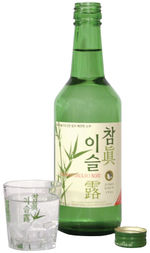 My current interest in soju started off with this headline in the Chosun Ilbo Jinro Soju, Still World's Number One . I guess I don't really find it too hard to believe "...that each one of some 35 million adults over 19 years of age drank 46 bottles last year." But, I was inspired to do a little research and was surprised (although I don't know why) to find that Wikipedia had a page devoted to the vile poison which explained that from 1965 to 1991, when I had my first exposure to soju, it was made of ethanol, water, and flavoring.
My current interest in soju started off with this headline in the Chosun Ilbo Jinro Soju, Still World's Number One . I guess I don't really find it too hard to believe "...that each one of some 35 million adults over 19 years of age drank 46 bottles last year." But, I was inspired to do a little research and was surprised (although I don't know why) to find that Wikipedia had a page devoted to the vile poison which explained that from 1965 to 1991, when I had my first exposure to soju, it was made of ethanol, water, and flavoring.I was surprised to learn that it was traditionally made from rice, was about 45% alcohol, and that "A great number of men naturally developed the art of drinking the strong soju without getting drunk." Clearly, the art of not getting drunk has disappeared. I have always thought of soju as a nasty chemical drink whose only purpose was to make people so incredibly drunk that they would not remember vomiting on the sidewalk.
I have long been under the misguided impression that the Korean rice based drinks were makkoli and dong dong ju (my personal favorite).
So, of course, I had to go directly to the source of soju knowledge in Seoul - Jinro - and clearly things have improved. None of the following was possible 20 years ago when I first came to Korea.
Like Vodka or Jin, Jinro Soju has most no taste making it easy to enjoy. Its is relatively low alcohol content (only 24%) helps lessen the burdon on your body unlike most other spirits with much higher alcohol contents. Whether you drink it straight or with a twist of lemon, it will go down very smooth.And about their premier soju - Chamjinisulro:
Because Chamjinisulro has been filtered twice, it has never been leaving no harmful ingredients or impurities. You can enjoy pure taste without the burden of hangovers due to it's containing asparagine and affulent minerals.Imagine my surprise - no hangover. I remember both a vile taste and a nasty hangover.
Soju Lite
Then I discovered that the Doosan Group was reducing the alcohol content of their soju.
Doosan Liquor BG Vice President Sung Jae-chul said, “We decided to make it one-proof lower based on the results of a consumer survey, which showed that consumers nowadays place top priority on a soft flavor when selecting a soju brand and the current trend for preference of lower-proof sojus.”Oh, yes. Today's discerning soju drinker probably is looking for a soft flavor - as opposed to the cheap quick drunk that was desired in the past.
Then of course, a Doosan spokesperson reading from a different page:
The alcohol content in the new brand was reduced from 21 to 20 percent and the price is 70 won (about 7 cents) cheaper than the mainline version.This, of course, shows the generous social consciousness of the company. Imagine a company nowadays that would cut costs and pass the savings on to its customers - all with the selfless desire to help people get drunk and forget their economic hardships. (I have to stop here to wipe a tear from my eye.)
Han Key-sun of Doosan's beverage division said the alcoholic content was reduced to cut costs and the savings passed along to consumers who imbibe to forget their economic hardships.
Continuing my research, I came across another thought-provoking survey to contrast with the newspaper report mentioned at the beginning of this post. The Chosun Ilbo in 2005 cited a report by Prof. Chang Keun-ho of Hongik University, "...Korean people aged over 15 consumed 68 bottles of soju a head in 2003." So, people between the ages of 15 and 17 accounted for the increase from 46 bottles per person reported in the newspaper to 68 cited in Prof. Chang's study. That's some serious drinking by underaged kids. Then, of course, trusting surveys to provide real accurate information is always iffy.
Then the final headline: Soju the Firewater of Choice for Korean Women. But, of course, “Women usually drink to create a friendly atmosphere, and this shows that drinking can be a way of spending leisure time with family and thus serve as a means of increasing intimacy between family members.” I'm not sure if the author of this "news" report just fell off the turnip truck. This isn't news. It has been known since the first batch of alcohol was brewed that men offer women alcohol both to create a friendly atmosphere and as a means of increasing intimacy. We sometimes use chocolate, but we've found that liquor is quicker.


No comments:
Post a Comment